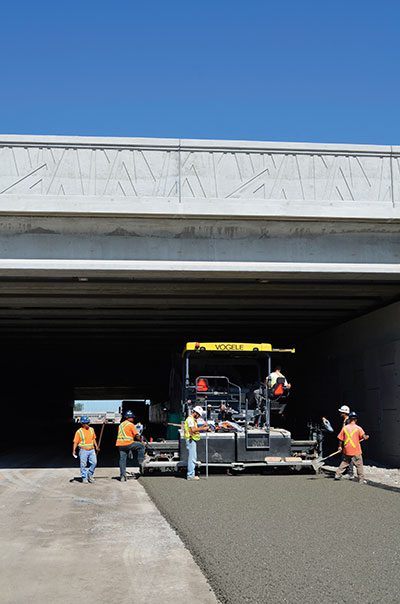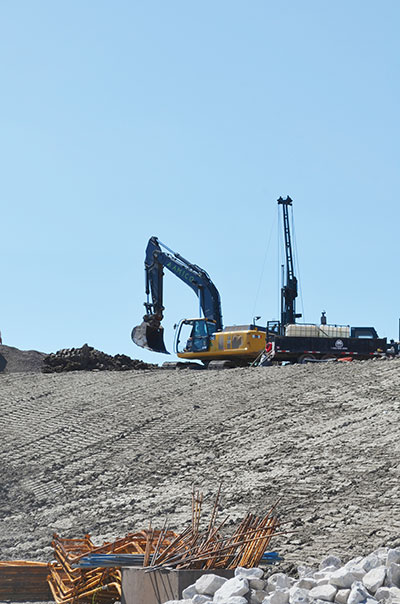
Features
Projects
Roads & Paving
Corridor Construction
Herb Gray Parkway project to improve Canada/U.S. trade
September 29, 2014 By Andrew Macklin
When you consider that Canada and the United States traded over $600
billion in 2013, it is easy to understand why the highway infrastructure
near Ontario’s border crossings would be a high priority for the
Ministry of Transportation.
When you consider that Canada and the United States traded over $600 billion in 2013, it is easy to understand why the highway infrastructure near Ontario’s border crossings would be a high priority for the Ministry of Transportation.
 |
|
| The specs for the construction of the asphalt roads included the use of an A/C treated Open Grade Drainage Layer (OGDL).
|
The International Bridge in Windsor, Ontario, is the busiest of all of the province’s border crossings, with $108 billion of goods travelling from Canada to U.S. via that route in 2013 according to MTO. That represents nearly one-third of the $358 billion in goods sent stateside last year (Statistics Canada).
In 2005, the Ontario Ministry of Transportation understood that it was time to re-evaluate the transportation network surrounding the Windsor-Detroit crossing and subsequently launched the Detroit River International Crossing (DRIC) study. According to MTO, “The purpose of the study was to identify a new end-to-end border transportation system that will link Highway 401 to the U.S. Interstate system with inspection plazas and a new river crossing in between.” That involves improving system connectivity, providing new border-crossing capacity and improving operations and processing capabilities.
In May of 2008, the DRIC study came back with a plan for a new Windsor-Essex Parkway, significantly improving the quality and efficiency of the highway network extending from the outskirts of Windsor to the International Bridge. The plan called for an extension of Highway 401 straight through the city, eliminating the stoplight system in place on Highway 3, which provided the original link from the 401 to the bridge.
The decision was made to tender the construction project as a design/build/finance/maintain (DFBM) delivery model on a 30-year contract. In December of 2010, the DFBM contract was signed between Infrastructure Ontario and the Windsor Essex Mobility Group (WEMG) at a contract value of $1.4 billion. WEMG consists of a consortium of companies that includes ACS Infrastructures Canada Inc., Acciona Concessions Canada and Fluor Canada Ltd.
In August of 2011, construction officially began on the renamed road, dubbed the Herb Gray Parkway in honour of the Rt. Honourable Herb Gray, who represented Windsor as an MP for 13 terms of office and served as Deputy Prime Minister from 1997 to 2002 in the Chrétien government.
The full scope of the project involves three distinct sections: a below-grade, six-lane extension of Highway 401, an at-grade extension of Highway 3 with four lanes, and a 20km multi-use trail system set within 120 hectares of green space. Including the work being done with the construction of a new International Bridge, a total of 15 bridges and 11 tunnels covering 1.8km are included in the project. There is also a significant environment component attached, involving the planting of 100,000 shrubs and trees and complemented by native grasses and wildflowers. As part of the extensive pedestrian component, there are two pedestrian tunnels and seven pedestrian bridges.
Getting involved
Amico Infrastructures Inc. was one of the first subcontractors officially hired to work on the construction of the Herb Gray Parkway. Based in Windsor, Amico was able to provide the local knowledge that was necessary to move the project forward.
 |
|
| There is also a significant landscaping component to the project, which involves the planting of 100,000 trees and shrubs.
|
“We knew the location (of the new highway), we had the dump sites, and we know about the local subcontractors that we could work with on the project,” says Dwayne Dawson, Manager of Infrastructure at Amico.
Amico has used its knowledge to provide many of the road construction aspects of the job, including the earth excavation, all of the sewers, water main work, sub-drains, OGDL, asphalt paving and concrete curbs. That work has involved over 100 workers on the ground for construction of the highway, plus another 30-35 staff in-house providing environmental, safety, quality and design work for the project. They are also using over 70 pieces of heavy equipment on the job, much of which are Caterpillar and John Deere machines thanks to existing relationships with both manufacturers.
Not long after Amico was hired as the primary subcontractor, a natural partnership was formed with Lafarge to provide the aggregates for all aspects of the construction.
“We (Lafarge) wanted in on the project and they (WEMG) wanted a partner who could provide a consistent, high-quality supply of product,” says Paul Sloan, Territory Manager-Canadian Docks for Lafarge.
The natural partnership was built based on three Lafarge mega-quarries that could supply the Herb Gray Parkway project by boat: Marblehead Quarry in Ohio, Presque Isle Quarry in Michigan and Manitoulin Quarry in Ontario. Between the three quarries, Lafarge is providing a few million tonnes of limestone aggregate of varying specs for the roadway, including over one million tonnes in 2013.
In the following months, several other subcontractors were added to the list of companies that are involved in the building stage of the project. That list of companies includes Coco Paving, who was brought in to provide at-grade concrete paving.
To get the job done within a reasonable amount of time, the province decided to allow construction at multiple locations simultaneously, as opposed to other highway projects that move from one end to the other. That work has been done successfully thanks to a series of diversion roads spread throughout the length of the roadway. In total, 26-lane kilometres of diversion roads have been built, all of which will be removed once the permanent roads have been opened to traffic.
The specs for the construction of the asphalt roads also include the use of an A/C treated Open Grade Drainage Layer (OGDL). The MTO requires that the OGDL be laid with only virgin bedrock material, and must be HL4 coarse aggregate as per OPSS 1003.

|
|
| The OGDL was put in place using a Vogele Super 2100-2 paver incorporating a Leica system for accuracy. The use of a high frequency vibrating screed helps to pack the material, which is not machine compacted.
|
Amico was in charge of the OGDL as part of its contract for all of the asphalt paving work on the project. The OGDL was put in place using a Vogele Super 2100-2 paver incorporating a Leica system for accuracy. The use of a high frequency vibrating screed helps to pack the material, which is now machine compacted. Variances in the placement are corrected by staff, who use special attachments to their boots to smooth out the irregularities. The OGDL is held to a tolerance of plus or minus 10mm, with 0.25-0.5 veracity to allow water to move freely out of the paving structure.
The OGDL is given two days to cure. Once the curing period is complete, a delineator is placed on the surface to observe the differences in the mat for measurement purposes.
The OGDL will help prevent any flooding concerns on the new highway, much of which is built below the Highway 3 system that previously took motorists to the International Bridge. Windsor is prone to getting its share of severe storms, and the use of the OGDL should help provide the necessary drainage to keep the movement of goods flowing regardless of weather conditions.
Overcoming obstacles
The Parkway has remained on its original timeline despite a major setback during construction. Concrete girders fabricated by Freyssinet were rejected after it was discovered that unauthorized materials had been used in certain girders and additional fabrication issues were uncovered. The decision was unrelated to the use of tack welding in girders manufactured by Prestressed Concrete Systems (PSI).
The girder issues forced MTO to perform destructive testing of the North Talbot Road Bridge, which resulted in the deconstruction of the bridge. Eight girders on the bridge were rejected as a result of the testing that had been done and the decision was made to remove the bridge rather than create the potential for an unsafe situation.
Community benefits
Ultimately, it is the community that could benefit the most from the construction of the Herb Gray Parkway, according to Dawson.
“I like to think that, hopefully, this will open up new business opportunities for Windsor.”
Print this page